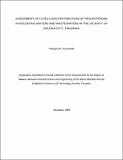| dc.contributor.author | Kasambala, Hildegard | |
| dc.date.accessioned | 2020-10-09T08:18:19Z | |
| dc.date.available | 2020-10-09T08:18:19Z | |
| dc.date.issued | 2020-12 | |
| dc.identifier.uri | https://doi.org/10.58694/20.500.12479/970 | |
| dc.description | Dissertation Submitted in Partial Fulfilment of the Requirements for the Degree of
Master’s in Environmental Science and Engineering of the Nelson Mandela African
Institution of Science and Technology, Arusha, Tanzania. | en_US |
| dc.description.abstract | This study aimed at investigating the levels and distribution of progesterone in receiving waters
and wastewaters in Arusha, a fast-growing urban area and third largest city in Tanzania. Also,
intend to assess the efficiency of waste stabilisation ponds (WSP) and constructed wetland
(CW) in removing progesterone. The study was conducted along the Themi River, (WSPs) and
CW. Progesterone was detected and quantified by using an Enzyme-Linked Immunosorbent
Assay (ELISA) kit. For Themi River samples, the level of progesterone obtained ranged from
‘no detection’ to 439.00 ng/L with a mean value of 120.30 ng/L. The levels detected were
significantly higher in the midstream three times and seven times than upstream and
downstream, respectively (P ˂ 0.05). Progesterone was spatially distributed much at midstream
than upstream and downstream. The elevated values at midstream were attributable to
livestock, WSPs and household effluents; agricultural activities; and sewage infiltration.
WSPs were observed to release 215 ng/L of progesterone at effluent with zero progesterone
detected at the effluent from CW with a removal efficiency of 75% and 100% for WSP and
CW, respectively. Although progesterone removal efficiency was high, the amount released
was still high enough to cause harm to aquatic organisms. Progesterone levels in the present
study, although not extremely high, correspond to those associated with harmful effects in
other studies. Therefore, this study suggests that anthropogenic activities conducted nearby
the rivers should be strictly avoided to reduce the amount of progesterone to be released to
the river. | en_US |
| dc.language.iso | en | en_US |
| dc.publisher | NM-AIST | en_US |
| dc.rights | Attribution-NonCommercial-ShareAlike 4.0 International | * |
| dc.rights.uri | http://creativecommons.org/licenses/by-nc-sa/4.0/ | * |
| dc.subject | Research Subject Categories::NATURAL SCIENCES | en_US |
| dc.title | Assessment of levels and distribution of progesterone in receiving waters and wastewaters in the vicinity of Arusha city,Tanzania | en_US |
| dc.type | Thesis | en_US |


